

Hazard Perception Test
The following official DVSA introduction video would be played at the start of the Hazard Perception Test. If you wish to watch this video please roll the mouse pointer over the image below and click the play button.
PlayHazard Types
There are 13 common hazard types or categories that you need to look out for while on the test or indeed while on the road for real. These are shown below.
Zebra crossings & traffic controllers
The first type of hazard commonly featured on the Hazard Perception Test is triggered when: A pedestrian approaches a zebra crossing with the intention of moving onto the crossing or; A school crossing patrol officer moves to the edge of the road and shows a stop for children sign or; An authorised traffic controller gives a signal to stop.

Pedestrians: Children & young adults
Children are often more interested in the game they are playing than road safety. Hence, whenever you see a child up ahead remember they may not be aware of your presence and may step or cycle into the road. If a child runs across the road they may well be followed by another child. If a ball or Frisbee appears on the road it may well be followed by a child.

Pedestrians: Elderly & infirm
It is not uncommon for the elderly or infirm to need more time to cross the road or enter or exit a vehicle. An elderly person may also suffer from a number of age related illnesses that prevent them from seeing, hearing or comprehending how fast traffic is approaching. They may simply underestimate how quickly they can move. Therefore watch out for the elderly or infirm as they cross the road or enter or exit vehicles.

Pedestrians: Adults
Even able-bodied responsible adults sometimes end up on the road when they shouldn't. Unfortunately, their attention may be distracted or they may be so involved with another task they forget the dangers of stepping onto the road. Alternatively, they may be under the influence of drink or drugs.
Therefore, watch out for adults washing, repairing, loading or unloading vehicles at the side of the road. Indeed, watch out for anyone who is undertaking some task or job near the side of the road. Watch out for pedestrians crossing between parked cars; they may not have seen you. Basically, watch out for any pedestrians who do not seem to have their full attention on the road they are crossing or stepping onto.

Cyclists & motorcyclists
Cyclists are very vulnerable, not easy to see, travel at relatively low speeds and need space to wobble. Drivers overtaking cyclists often do not give them sufficient room or appreciate how quickly they will be upon them. This leads to a number of hazards involving the overtaking of cyclists particularly where the road ahead becomes narrow and does not permit you to give adequate clearance while overtaking or where your view of the road ahead is impeded. Because cyclists are usually travelling so much slower than normal traffic you do need to be prepared to slow down in plenty of time.
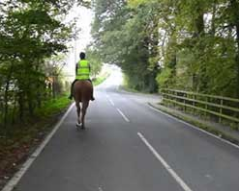
Horse riders & other animals
Horse riders like cyclists travel at relatively slow speeds and following or approaching traffic can be upon them far more quickly than the driver appreciates. This can result is harsh braking and/or vehicles overtaking horse riders when it is not safe to do so. Just like cyclists you need to give horse riders plenty of room when you overtake them.
You also need to appreciate that the horse might be startled as you overtake particularly if you are travelling too quickly or too close. This could result in the rider being thrown from the horse and/or the horse bolting into the path of any overtaking or approaching vehicle.
Therefore, you must drive slowly when approaching or overtaking a horse rider irrespective of the room you might have. Any sudden noise would also cause the horse to become unsettled so avoid the use of the horn and do not rev the engine.
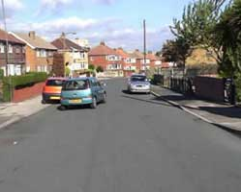
Vehicles: moving off or pulling up
Vehicles ahead moving off or pulling up may represent a potential hazard depending upon whether they may cause you to slow down, overtake or stop. The driver of a vehicle moving off ahead might not have seen you or may have misjudged your speed causing you to have to slow down, stop or overtake.
A vehicle moving off from behind parked vehicles may also need to swing out into the road impeding progress of both following and approaching traffic. Therefore, watch for any vehicles ahead moving off and assess whether it may cause you a problem. Usually an indicator signal warns you of this developing hazard ahead.
However, sometimes the signal may not be applied or may have automatically turned off as they commence the manoeuvre, therefore you should also watch out for vehicles edging out from behind a row of vehicles ahead. Alternatively, you might see the driver or passenger entering the vehicle just prior to moving off or a person waving goodbye.

Vehicles: meeting
Traffic Vehicles meeting are one of the most common potential hazards you are likely to come across particularly if you live in a busy suburban area where parking is at a premium. This hazard appears whenever the road narrows so that only one vehicle can proceed at a time or where two vehicles can proceed but only very slowly. Single track country roads also present a similar problem although you are less likely to meet volumes of traffic. Sometimes approaching large vehicles can cause this situation simply because of their width.
Deliberate road narrowing is also used as a traffic calming measure. Where it is a physical feature road signs usually exist to warn you of this hazard and who, if anyone, has priority. If the road narrows due to an obstruction on your side of the road you are required to give priority to approaching traffic unless road signs state otherwise or it is clear that the opposing vehicle wants you to proceed first.

Vehicles: emerging
we have already covered how cyclists and horse riders can particularly present a problem when emerging. However, in this category we will focus on the other vehicle types that might cause a hazard when emerging.
Slow moving or long vehicles can often present a hazard as they emerge from a side road. Sometimes it is difficult for the driver of the emerging vehicle to see any approaching vehicles (particularly motorcyclists) or properly assess their speed with the result that the vehicle emerges into the road when it is not safe to do so. You could argue that this is the fault of the emerging driver; however, this is little consolation if you are involved in an accident.
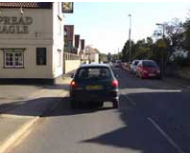
Vehicles: turning left or right
Any vehicle ahead that may be reducing speed, changing position or turning represents a potential hazard and should command your attention.
Provided drivers ahead have given adequate warning of their intention to turn left or right and provided nothing impedes them from completing the task this rarely results in a developing hazard. Hence, when a vehicle ahead gives a signal to turn left or right it is not necessarily the start of a developing hazard.
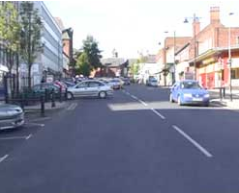
Vehicles: reversing & U-turns
Vehicles ahead reversing into the main road from a side-road, a drive-way or a parking space or parking bay may cause you to stop, slow down or overtake and as such are another common hazard you need to look out for.
When a driver is reversing out, their view and ability to move away quickly is significantly reduced from driving out forwards. Consequently, if you see a car reversing ahead it is quite possible they may not have seen you or misjudged the time it will take them to emerge and drive away. Hence, reversing vehicles often are a sign of the start of a developing hazard ahead. The Highway Code advises the following in this regard:
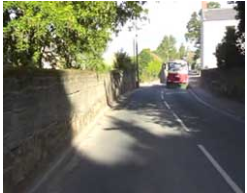
Vehicles: larger Vehicles
Large vehicles can present a number of potential hazards due to their size and weight when manoeuvring. When moving off or emerging they are usually much slower than smaller vehicles and therefore need more time to emerge. Emerging vehicles may also need to swing onto the other side of the road even when emerging to the left from a junction due to their length, the shape of the junction or the circumstances that prevail at the time.
On narrow roads or at certain bends the width and/or length of a large vehicle may cause the vehicle to move onto the opposite side of the road causing oncoming vehicles to slow down, stop and/or move position. Therefore, you need to recognise when an approaching large vehicle may impede your progress due to the layout of the road ahead and the vehicles physical dimensions.
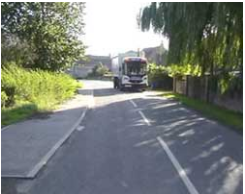
Vehicles: flashing lights
Slow moving utility, works and agricultural vehicles have flashing amber lights to warn you that they present a hazard. The vehicles may simply be driving along or undertaking some task such as gritting the road, cutting grass or hedges, collecting refuse etc. When stationary expect to see work-men round about these vehicles.
Amber flashing lights mean hazard so as soon as you see the lights click the mouse button and click again as soon as you recognise the problem it will cause to you. This is the advice given by the Highway Code on vehicles with amber flashing lights: